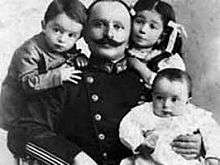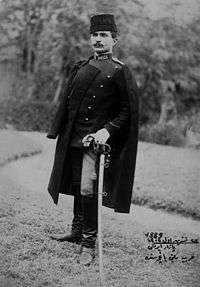Fakhri Pasha
| Ömer Fahrettin Türkkan[1]
1304 (1888)-SV. 1[1] | |
|---|---|
 Ömer Fahrettin Pasha with his children | |
| Nickname(s) |
The Defender of Medina (Tr.: Medine Müdafii) The Lion of the Desert[2] The Tiger of the Desert[3] |
| Born |
1868(November or December) Rusçuk, Ottoman Empire |
| Died |
22 November 1948 (aged 79–80) Istanbul, Turkey |
| Buried at | Aşiyan Cemetery |
| Allegiance |
|
| Service/branch |
|
| Years of service | 1888–1919, 1921–1936 |
| Rank | Ferik |
| Commands held | 31st Division, XII Corps, Fourth Army (deputy), Hejaz Expeditionary Force |
| Battles/wars |
Italo-Turkish War Balkan Wars World War I |
| Other work | Turkey's ambassador to Kabul. |
Fakhri Pasha or Fahreddin Pasha (1868 – 22 November 1948), known as Ömer Fahrettin Türkkan after the Surname Law of 1934, was the commander of the Ottoman army and governor of Medina from 1916 to 1919. He was nicknamed "The Lion of the Desert" and "The Tiger of the Desert"[3] by the British for his patriotism in Medina.[2]
Early life

He was born in Rusçuk (present day: Ruse) to mother Fatma Adile Hanım and father Mehmed Nahid Bey. He had a younger sister Fehime Hanım. Due to the Russo-Turkish War his family moved to Constantinople[4][5] in 1878. He joined the War Academy and in 1888 graduated from it. His first posting was on the eastern border with Armenia in the Fourth Army. In 1908 he came to Constantinople and joined the First Regular Army. In 1911–12 he was sent to Libya and when the Balkan War broke out, he was the commander of the 31st Division stationed at Gallipoli. His unit snatched Adrianople (present day: Edirne) from Bulgaria and he entered into the city along with Enver Pasha.
Family
He married in 1900 Ayşe Sıdıka Hanımefendi (1884-1959), daughter of Ferik Ahmet Paşa and got issue:
- Suphiye Türkkan 1904-1978 (daughter)
- Mehmed Selim Türkkan 1908-1991(son)
- Mehmed Orhan Türkkan 1910-1994 (son)
- Ayşe Nermin Türkkan 1919-1997 (daughter)
- Ayhan Türkkan 1928-4.2.1959 (son)
World War I
In 1914, before the Ottoman Army was mobilized, Staff Colonel Fahreddin Bey was appointed the commander of the XII Corps stationed in Mosul. He was promoted to the rank of Mirliva on 12 November 1914 and appointed to the Deputy Commander of the Fourth Army stationed in Aleppo.[6]
Defender of Medina

During World War I, Fahreddin Pasha upon the orders of Djemal Pasha on 23 May 1916 moved toward Medina in Hejaz to defend it and he was appointed the commander of the Hejaz Expeditionary Force on 17 July 1916.[6]
Fahreddin Pasha was besieged by the Arab forces who betrayed the Ottoman Sultan and sided with the British against him but pasha stood ground and tenaciously defended the holy city. Fahreddin Pasha not only had to defend Medina but also protect the single-track narrow gauge Hejaz Railway from sabotage attacks by T. E. Lawrence and his Arab forces, on which his entire logistics depended.[7] Turkish garrisons of the isolated small train stations withstood the continuous night attacks and secured the tracks against increasing number of sabotages (around 130 major attacks in 1917 and hundreds in 1918 including exploding more than 300 bombs on April 30, 1918).[7]
With the resignation of the Ottoman Empire from the war with the Armistice of Mudros between Ottoman Empire and Entente on 30 October 1918, it was expected that Fahreddin would also surrender. But he refused to do so and simply refused to accept the armistice.
According to eye-witness memoirs of Turkish author Feridun Kandemir, who was a Red Crescent volunteer of that time in Medina, one Friday in the spring of 1918, after prayers in Masjid al-Nabawi (also known as the Prophet's Mosque), Pasha addressed the troops:[9]
"Soldiers! I appeal to you in the name of the Prophet, my witness. I command you to defend him and his city to the last cartridge and the last breath, irrespective of the strength of the enemy. May Allah help us, and may the prayers of Muhammad be with us.
"Officers of the heroic Turkish army! O little Muhammads, come forward and promise me, before our Lord and the Prophet, to honor your faith with the supreme sacrifice of your lives."'
Fahreddin Pasha had said that he had a vision in a dream that the prophet Muhammad had ordered him not to submit. In August 1918, he received a call to surrender from Sharif Husain of Mecca. Fahreddin Pasha replied him in these words:[9]
"Fakhr-ud-Din, General, Defender of the Most Sacred City of Medina. Servant of the Prophet.
"In the name of Allah, the Omnipotent. To him who broke the power of Islam, caused bloodshed among Muslims, jeopardized the caliphate of the Commander of the Faithful, and exposed it to the domination of the British.
"On Thursday night the fourteenth of Dhu'l-Hijja, I was walking, tired and worn out, thinking of the protection and defense of Medina, when I found myself among unknown men working in a small square. Then I saw standing before me a man with a sublime countenance. He was the Prophet, may Allah's blessing be upon him! His left arm rested on his hip under his robe, and he said to me in a protective manner, 'Follow me.' I followed him two or three paces and woke up. I immediately proceeded to his sacred mosque and prostrated myself in prayer and thanks [near his tomb].
"I am now under the protection of the Prophet, my Supreme Commander. I am busying myself with strengthening the defenses, building roads and squares in Medina. Trouble me not with useless offers."
He refused to hand over his sword even upon the receipt of a direct order from the Ottoman minister of war. The Ottoman government was upset upon his behavior and the Sultan Mehmed VI dismissed him from his post. He refused to do so and kept the flag of Ottoman Sultan high in Medina until 72 days after the end of the war. After the Armistice of Moudros the closest Ottoman unit was 1300 km (808 miles) away from Medina.[10]
Fahreddin was arrested by his own men and brought to Abdullah on 9 January 1919 at Bir Darwish.[11][12] Abdullah entered Medina shortly after the surrender, followed by Ali who entered the city on 2 February 1919.[12]
Life after War
After his arrest, he was brought to the military barracks at Cairo, Egypt. Later, he was transferred to Malta.[13] Fahreddin Pasha lived as a prisoner of war for over two years in Malta until 1921.[13] After his release in 1921, he joined the Turkish forces under the command of Mustafa Kemal Atatürk and fought against the Greek and French armies occupying Anatolia. After the Turkish War of Independence, he became Turkey's ambassador to Kabul, Afghanistan between 1922 and 1926.[14] In 1936, he was promoted to the rank of Ferik (Lieutenant General) and retired from the army. He died on November 22, 1948, after suffering a heart attack during a train trip in the vicinity of Eskişehir.[13] According to his wishes, he was buried in the Aşiyan Cemetery in İstanbul.[13]
See also
External links
- Picture of Fahreddin Pasha
- Campaign of Arabia, detailing the Arabian Peninsula front
- Photo of Fahreddin Pasha inspecting troops in Medina
- Photo of Fahreddin Pasha (sitting right) with Ali Necip Bey
Sources
- 1 2 Harp Akademileri Komutanlığı, Harp Akademilerinin 120 Yılı, İstanbul, 1968, p. 19. (Turkish)
- 1 2 Defence Of Medina, İsmail Bilgin, ISBN 975-263-496-6, Timas Publishing Group.
- 1 2 S. Tanvir Wasti
- The defence of Medina, 1916–19, Middle Eastern Studies
- ↑ The Encyclopædia Britannica, Vol.7, Edited by Hugh Chisholm, (1911), 3; Constantinople, the capital of the Turkish Empire...
- ↑ Britannica, Istanbul:When the Republic of Turkey was founded in 1923, the capital was moved to Ankara, and Constantinople was officially renamed Istanbul in 1930.
- 1 2 "Fahreddin Paşa (Türkkan)", Turkey in the First World War.
- 1 2 Mesut Uyar, Edward J. Erickson: A Military History of the Ottomans: From Osman to Atatürk, ABC-CLIO, 2009, ISBN 0275988767, He initiated the Awali Massacre that turned the Arab thought of combat inside out, that was that women and children too young to bear arms were non combatants and immovable property was left unharmed. Fakhri's experience in the Armenian Genocide taught him many ways to kill, all of which he used to suppress the[8] Arab Revolt Awid=JgfNBKHG7S8C&printsec=frontcover&dq=from+osman+to+atat%C3%BCrk&hl=de&sa=X&ei=wH2_T8ieK67P4QS8i_mICg&redir_esc=y#v=onepage&q=%22isolated%20small%20train%20stations%20not%20only%20withstood%20the%22&f=false page 253.
- ↑ Seven Pillars of Wisdom C13
- 1 2 Medine Müdafaası, Feridun Kandemir, Nehir Yayınları, s. 530, İstanbul, 1991
- ↑ Başbakan Erdoğan'ın sır konuşması, Sabah, 24.03.2012 (Turkish)
- ↑ Peters, Francis. (1994). "Mecca: A Literary History of the Muslim Holy Land". PP376-377. Princeton University Press. ISBN 0-691-03267-X
- 1 2 Wilson, Mary. (1987). "King Abdullah, Britain and the Making of Jordan". P36. Cambridge University Press. ISBN 0-521-39987-4
- 1 2 3 4 Fahreddin Paşa exhibition commemorates hidden jewel in Turkish photography, Today's Zaman, Ömer Faruk Șerifoğlu, 14.12.2008
- ↑ Bilal N. Șimșir, "Cumhuriyetin İlk Çeyrek Yüzyılında Türk Diplomatik Temsilcilikleri ve Temsilcileri (1920–1950)", Atatürk Araștırma Merkezi Dergisi, Sayı 64-65-66, Cilt: XXII, Mart-Temmuz-Kasım 2006. (Turkish)
- Public Record Office, London. F. O./371
- Emel Esin, Mecca The Blessed, Medinah The Radiant (London, 1963), p. 190